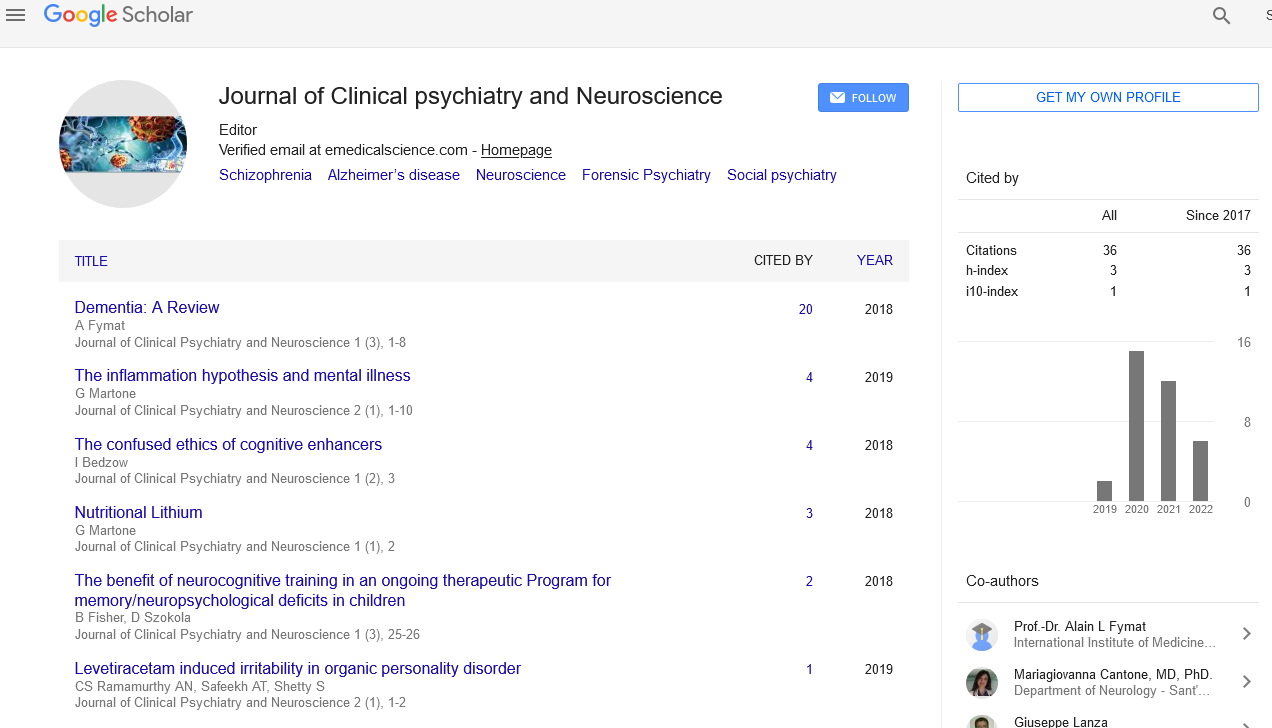Postural control in people with fibromyalgia and chronic fatigue syndrome
Received: 04-Sep-2022, Manuscript No. PULJCPN-22-5337; Editor assigned: 06-Sep-2022, Pre QC No. PULJCPN-22-5337 (PQ); Accepted Date: Sep 24, 2022; Reviewed: 19-Sep-2022 QC No. PULJCPN-22-5337 (Q); Revised: 22-Sep-2022, Manuscript No. PULJCPN-22-5337 (R); Published: 26-Sep-2022, DOI: 10.37532/puljcpn.2022.5(5).47-8
Citation: Raul S. Postural control in people with fibromyalgia and chronic fatigue syndrome. J Clin Psychiatry Neurosci.2022; 5(5):47-8.
This open-access article is distributed under the terms of the Creative Commons Attribution Non-Commercial License (CC BY-NC) (http://creativecommons.org/licenses/by-nc/4.0/), which permits reuse, distribution and reproduction of the article, provided that the original work is properly cited and the reuse is restricted to noncommercial purposes. For commercial reuse, contact reprints@pulsus.com
Abstract
A medical illness known as Fibromyalgia (FM) is characterized by the occurrence of lower abdomen pain or cramping, depression, exhaustion, and chronic generalized pain. Insomnia and a general hypersensitivity are further signs. Fibromyalgia is thought to be brought on by a confluence of genetic and environmental factors, while its exact aetiology is unknown. Environmental influences could include trauma, stress on the mind, and specific infections. The disease is known as "central sensitization syndrome" and the pain seems to be caused by central nervous system activities.
Keywords
Fibromyalgia
LETTER
Fatigue, sleep difficulty, and chronic, widespread pain are the hallmark signs of fibromyalgia. In addition, there may be visual symptoms, cognitive issues, musculoskeletal stiffness, environmental sensitivity, hypervigilance, sexual dysfunction, and increased discomfort in reaction to touch (allodynia).
One of the main symptoms of fibromyalgia is sleep issues. These include having trouble falling asleep or staying asleep, waking up during sleep, and waking up feeling drowsy. In healthy individuals and those with fibromyalgia, objective and subjective sleep metrics were compared. When measured objectively, people with fibromyalgia exhibited lower sleep efficiency and quality, as well as longer wake times following sleep onset, shorter sleep duration, lighter sleep, and higher trouble commencing sleep, and greater difficulty initiating sleep when measured subjectively. Sleep issues may make it more difficult for the body to repair damaged tissue by releasing less IGF-1 and HGH.
In general, executive function requires a fusion of cognitive and physical skills. Individuals with pain and tiredness typically report increased effort and difficulty doing cognitive tasks, and there is evidence of both cognitive impairments and motor control deficiencies in these patients
Common symptoms of pain and fatigue diseases, particularly chronic fatigue syndrome and fibromyalgia, include cognitive dysfunctions such decreased working memory, attention deficit, and less effective information-processing capacity. When compared to other symptoms, cognitive impairments are typically more upsetting for these people.
Neuroimaging has shown structural and functional abnormalities in the central nervous system in both CFS and FM, as well as a pattern of increased neuronal recruitment when performing cognitive activities. Notably, recent research suggests that both FM and CFS patients have accelerated ageing of certain brain regions, which may impair their capacity to perform a variety of tasks. It is anticipated that adding a cognitive work while still maintaining postural control in a quiet standing position will put more strain on the central nervous system and impair postural stability.
A healthy person's regulating approach appears to tighten when a cognitive component is added to preserve postural stability. There were no interactions that supported various postural control methods in response to the concurrent cognitive task in patients when the intrinsic patterns in all groups followed a similar profile at baseline and in the experimental condition. However, bigger amplitude and lower frequency in the slow component reflecting postural sway and larger in both patient groups indicated poor postural control as compared to controls. These individuals report having to work harder to perform after exerting themselves physically and mentally, which is considered to be persistent post exertional weariness. The impact of increased brain activity and neural recruitment during cognitive tasks on motor control is still unknown. Although they must be acknowledged, the effects of pain and tiredness on motor function are commonly disregarded. Pain and weariness are common symptoms across diseases and diagnoses and may be brought on by alterations to regulatory systems in the Central Nervous System (CNS), especially in areas that are not controlled voluntarily. As abnormalities in balance and postural steadiness have been shown in FM and CFS patients, as well as similar deficiencies in dynamic postural control at gait beginning, pain and fatigue perception may interfere with this process. The fact that perception-action connection and interactions between the brain, body, and environment serve as common basis for behavior without representational domain separation is noteworthy. Since neural networks from different cortical regions are shared, performance issues in either domain may arise when they are applied simultaneously. For proper motor output, such as balance control, attention and sensory integration are necessary. Given that maintaining and updating internal models is essential for sensory motor learning, this may have an effect on some elements of motor performance. It is hypothesized that patients swayed more as a result of an imbalance in the magnitude and frequency of the regulating ankle torque. The CFS group differed more from controls than the FM group, which suggested a marginally subpar overall performance. It appears that weariness is the fundamental cause of both groups' poor postural control because there are correlations between fatigue and postural control but not between pain and postural control. Between the patient groups, there were no statistically significant differences.





